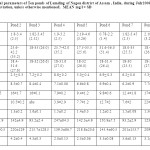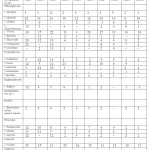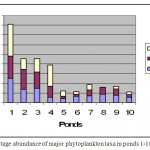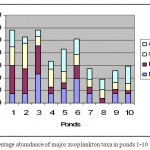Hydro biological Characteristics of Some Semi-intensive fish culture ponds of Lumding town of Nagaon district, Assam
Tapashi Gupta1 * and Dr. Mithra Dey2
1
Department of Zoology,
Lumding College,
Lumding,
Assam,
782447
India
2
Department of Ecology and Environmental Sciences,
Assam University,
Silchar,
788011
India
DOI: http://dx.doi.org/10.12944/CWE.8.1.15
Copy the following to cite this article:
Gupta T, Dey Mithra. Hydro biological Characteristics of Some Semi-intensive fish culture ponds of Lumding town of Nagaon district, Assam. Curr World Environ 2013;8(1) DOI:http://dx.doi.org/10.12944/CWE.8.1.15
Copy the following to cite this URL:
Gupta T, Dey Mithra. Hydro biological Characteristics of Some Semi-intensive fish culture ponds of Lumding town of Nagaon district, Assam. Curr World Environ 2013;8(1). Available from: http://www.cwejournal.org/?p=3045
Download article (pdf) Citation Manager Publish History
Select type of program for download
| Endnote EndNote format (Mac & Win) | |
| Reference Manager Ris format (Win only) | |
| Procite Ris format (Win only) | |
| Medlars Format | |
| RefWorks Format RefWorks format (Mac & Win) | |
| BibTex Format BibTex format (Mac & Win) |
Article Publishing History
| Received: | 2012-12-08 |
|---|---|
| Accepted: | 2012-12-25 |
Lumding is situated in Nagaon District of Assam and lies between 25045/- 26045 North latitudes and 91050/ -93020 /East Latitudes. Lumding is the second biggest town in Nagaon district of Assam. A large section of the people of Lumding depends on Agriculture, Poultry, and Fishery etc. as their means of livelihood. There are about 171 fish ponds constructed and stocked with fish in Lumding and its adjacent area. Some of these are not utilized to its full potential. Studies on physico-chemical condition of ground water of Lumding have already been done by Mrinal Kanti Paul(M.K.paul&A.K.Mishra2009) but the detailed data on the hydro- biology of available water bodies of Lumding still remained scanty. In view of the vast extension of such water bodies which occupies about one third of the plain area of Lumding, the present study was undertaken to evaluate the hydrobiology of ten ponds of Lumding, which will provide certain information in the survey of the Fishery resources of Lumding and in the proper planning of the fisheries management programme of the town.
The interrelationship between the physico-chemical parameters and plankton production of pond water and its relation with fluctuation of plankton are of great importance and basically essential in fish culture. Fishes are dependent on physico-chemical parameters. Any change of these parameters may affect the growth, development and maturity of fish (Jhingran,1985).
Phytoplankton is the major primary producers in many aquatic systems and is important food source for other organisms (Sukumaran et al., 2008). Phytoplanktons not only serve as food for aquatic animal, but also play an important role in maintaining the biological balance and quality of water (Pandey et al.,). Zooplankton constitutes important food item of many fishes. The larva of carps feed mostly on zooplankton (Dewan et al.,1977). Zooplankton also plays an important role in the food chain, as they are second in trophic level as primary consumers and also contributers to next trophic level (Quasim,1977). The productivity of freshwater community that determines the fish growth is regulated by the dynamics of its physico-chemical and biotic environment (Wetzel, 1983). The pH, dissolved oxygen, alkalinity and the dissolved nutrients are important for the phytoplankton production (Bais & Agarwal, 1990). Plankton diversity responds rapidly to change in the aquatic environment particularly in relation to nutrients.
Materials and Methods
The study was conducted during July 2009 to June 2011. Water samples were collected from ten locations randomly. Analysis of water samples were done following standard methods (APHA, 1995) and Trivedy & Goel(1984). Plankton samples for this study were collected with plankton net made of bolting silk cloth no.25 (mesh size: 0.03-0.04mm). Plankton net was used to collect plankton samples once in every month. Phytoplankton samples were preserved in Lugol’s iodine solution, while zooplankton samples were preserved in 4% formalin solution and then transported to laboratory for plankton analysis (Lackey, 1938).
The preserved samples were allowed to settle for 24 hrs and the surface water free of phytoplankton was siphoned out until the sample was reduced to 10ml. 1ml is pipetted from 10ml after shaking in to a sedwick rafter counting cell and mounted on microscope. The phytoplankton were counted and then identified. The volume of water filtered was calculated using the formula: п r2h r = radius of the net used h= the distance of trawling The actual number of each phytoplankton group/lit. of water filtered was calculated. This was then converted to number of individual group per cubic meter (m3). The zooplankton samples were analyzed in similar way like that of phytoplankton. The identification of plankton species was done with the aid of plankton identification key and monographs (Neeedham and Needham, 1962 ), Tonapi (1980), Battish (1992) and Bellinger (1992).
Pond water was collected from various depths by using boat and was collected to laboratory and analysis of water samples were done following standard methods (APHA, 1992), Trivedy and Goel (1984).
Results and Discussion
Depth
Minimum water depth was recorded during summer, which shows an increasing trend from July onwards and attained peak during August-September, followed by a gradual decreasing trend till May-June. The water depth in Pond NO.1 was highest (av. 3.26 m) and that at Pond No.6 was lowest (av. 1.41 m).
Transparency
Water transparency is an important factor that controls the energy relationship at different trophic levels. It is essentially a function of reflection of light from the surface and is influenced by the absorption characteristics of both of water and of its dissolved and particulate matter (Stepane,1959). Very high fluctuation of transparency was observed in Pond No.6 followed by others in decreasing order. From October to April, the poor to medium transparency were mainly caused by the abundance of zoo and phytoplankton population. The Murabasti ponds, which showed minimum transparency fluctuation, were most productive. In Pond No.6 transparency was very high (80-200cm) during initial period and the pond was very unproductive due to poor availability of plankton in pond water. A very high transparency, therefore, indicate the unproductive nature of water. Water transparency in the range of 20-50cm was found to be conducive for fish ponds.
Temperature
The water temperature at different location of Lumding ranged from 18-320C with mean value of 26.50C, 260C, 270C, 260C, 26.50C, 250C, 26.40C, 270C, 250C and 260C respectively. The water temperature remained below 200C for two months (December and January). The water temperature of the ponds remained within the range of 20-320C for about ten months in a year. The comparative higher temperature in tropical waters than in temperate region is considered to be beneficial for higher productivity in the former. The average water temperature of the ponds at different locations ranged between 25-270C. In the present study, it was generally noted that the growth of carps was optimum in the temperature range of 23-300C.
Dissolved Oxygen
The dissolve oxygen is the most important and critical parameter requiring continuous monitoring in aquaculture production systems. This is due to the fact that fish aerobic metabolism requires dissolved oxygen (Timmons et al.2001). The dissolved oxygen content of ten ponds ranged from 2.5-8.8ppm. Dissolve oxygen was higher during winter and lower during summer months. Bhowmick(1968), Jana(1973) and Chakraborty(1980)recorded a fluctuation of dissolve oxygen content in their experimental ponds located at West Bengal. During summer, when the temperature was high, fishes in some ponds at Lumding started surfacing during early in the morning when the oxygen content fell below 2.0ppm.
pH
The pH of water at different selected ponds ranged from 6.1-8.5. Pond No 2,3 and 10 were slightly alkaline whereas Pond No 5, 6, 7 and 9 were slightly acidic rests are within range. A slightly alkaline water (7.2-8.0) may be considered conducive for fish production. Nees (1946) and Banerjea (1967) observed the variation in water pH from 7.1-8.0 as optimum for fish production.
Total alkalinity
The total alkalinity of ten ponds of Lumding ranged from 7.9-20.5. Total alkalinity was minimum during the rainy day and maximum during summer season. However the total alkalinity is very low, indicating a paucity of carbonates. It implies that people would have to subject the water to treatment before fish farming as the changes of total alkalinity were influenced not only by climatic factors such as temperature and rainfall but also by fish culture practices such as liming and fertilization. Total alkalinity less than 100mg/l is not suitable for fish culture (Scroeder, 1980, Banerjea 1967).
Free Carbon dioxide
The free CO2 content in ponds at ten centres ranged from 3.9-22mg/l. To maintain a moderate level of CO2 in pond water, organic manures were applied uniformly at a regular interval to all the centres. But in the pond No 3 free carbon dioxide was absent. Absence of free carbon dioxide is due to its utilization by algae during photosynthesis or carbonate present (Manjare et al. 2010).
Total Hardness
The total Hardness ( Calcium +Magnesium hardness) at ten ponds ranged from 3.1-8.0 ppm The growth of plankton and fish were low as hardness was very low. Lakshmanan et al (1967) also recoded poor production of plankton and fish in acidic ponds in Assam having poor calcium content.
Total Dissolved Solids
Electrical conductivity can be used as an index of TDS (Sreenivasan,1964). TDS may consists of different kinds of nutrients and minerals.High amount of total dissolved solids was observed in pond no 9 during survey period.The total dissolved solids in ten ponds of Lumding fluctuated between 87-220 ppm. Highest value was recorded during October and lowest was recorded in June.
Specific Conductivity
Conductivity is an important parameter to determine the quality of water. The specific conductivity of ten ponds ranged from 93-247 umhos/cm.The maximum conductivity was recorded during summer season while minimum during winter season. Bhatt et al. (1999) observed the highest conductivity values in the month of May and lowest in the month of December from Taudaha lake. The specific conductivity of a freshwater pond should be in the range of 24-600 umhos/cm for optimum fish production and if less than 100 umhos/cm the pond might be poorly productive.
Biological Oxygen Demand
The BOD of ten ponds ranged from 0.6-7.2 mg/l. The normal level of Biological oxygen demand is 1.4-2.4 ppm. BOD is an indicator of organic pollution. BODS were more or less low in all the ten ponds of Lumding, which indicates low level of organic pollution of pond water.
Plankton composition was studied as the productivity of pond depends on plankton community. Plankton community is a heterogenous group of tiny plants (phytoplankton) and animals (zooplanktons) adapted to suspension in the sea and freshwater.
Phytoplankton and Zooplankton
The phytoplanktons of Assam beels were found very low except few beels. This was due to heavy growth of macrophytes, whereas availability of phytoplankton’s in the West Bengal beels ranged from 396-14987UL -1 (Sugunan, 2000). Quality composition of phytoplankton’s also varied in the beels of Assam and West Bengal. It varied from beel to beel and no definite pattern was followed. The phytoplankton’s comprises major portion in the pond. The basic process of phytoplankton production was dependent upon temperature, turbidity and nutrients as reported by Sreenivasan et al.(1979) and Sukumaran and Das(2002).The phytoplankton belonging to division Chlorophycae and Cyanophycae are predominant over the others. During the study period, a total of 1195 genera were observed among them 573 were phytoplankton and remaining 622 were Zooplankton. The phytoplankton’s present in different divisions were chlorophyeae (515), cyanoplyeae (262) and Euglenophycae(36). A total of 622 Zooplankton were observed among them Rotifers (26), protozoans (143), copepoda (173) and cladocera (280).
 |
Table 1: Physico-chemical parameters of Ten ponds of Lumding of Nagon district of Assam, India, during July 2009-June 2011 (units in mg/l +Standard Deviation, unless otherwise mentioned). MEAN mg/l ± SD Click here to View table |
 |
Table 2: Plankton Composition in the water sample of Ten Semi-intensive fish culture ponds during July2009-June 2011 Click here to View table |
 |
Figure 1: Percentage abundance of major phytoplankton taxa in ponds 1-10 Click here to View table |
 |
Figure 2: Percentage abundance of major zooplankton taxa in ponds 1-10 Click here to View table |
Conclusion
Quality of an ecosystem depends on the physico-chemical characteristics and biological diversity of the system(Tiwari and Chauhan,2006). Table 1 depicts the chemical variables of the water of ten ponds selected forstudy. The study clearly showed that the productivity of the ponds varied significantly depending upon the climatic conditions and their hydro biological and soil qualities. Pond No. 10 having high transparency, poor alkalinity was least productive whereas Pond No 5 having normal pH, Alkalinity having favourable physico-chemical conditions was highly productive. The physico-chemical characteristics of ten ponds are given below in Table1.
Variations in percentage occurance of major phytoplankton taxa in ponds 1 to 10 are shown in Fig 1. Major taxa present are Chlorophyceae, Cyanophyceae and Euglenophyceae. Among the three groups Chlorophyceae is present in all ponds.Euglenophyceae is totally absent in Pond 8. Cyanophyceae is present in Pond 5 and 6 in very low percentage.Planktonic algae are particularly sensitive to chemicalchanges and myriad environmental conditions promote the development of the algal spores present in the sediment(Rodhe,1948). Chlorophyceae and Cyanophyceae are the most common group of phytoplankton in the ponds studied.
Variations in percentage occurance of major zooplankton taxa in ponds 1 to 10 are shown in Fig 2. Major taxa are Rotifers, Protozoa, Copepoda and Cladocera. Among the four groups Protozoa, Copepoda and Cladocera are present in all ponds. Rotifers are present in nine pone ponds but totally absent in pond 8. Protozoa is the most common group of zooplanktonin the ponds studied but in pond 4, 5, 7, 8, 9, and 10 in low percentage whereas Cladocera are present in highest number than others. The highest phytoplankton abundance was found in August. The highest abundance of Zooplankton was recorded in July and lowest value was recorded in November.
The details of pond ecosystem in Lumding of Nagaon district, Assam has not been studied earlier and perfect accounts of physico-chemical and biological aspects are not available and no such type of studies on fish culture in relation to water quality have been carried out here. Therefore, the present studies have been conducted, focusing monitoring of water quality and fish food organism of some semi-intensive fish culture ponds.
The present findings indicate that water quality of all the ten ponds have good potential for fishery practice. The small rural ponds can be a very good source of income from fishery which can be augmented with scientific management as small ponds are more manageable and high yielding than larger ones. Hence it is necessary to protect and conserve these small water bodies. This demands immediate action from fishery biologists, planners and policy makers.
References
- APHA.1995. Standard Methods for the Examination of Water and waste water.18th edition. American Public Health Association, Washington, DC.
- Bais, V.S. and N.C. agarwal,1990: Seasonal variations of nitrogen contentsin the sediment and water of the Sagar lake. Bull. Environ Sci. 8:21-24.
- Banerjea, S.M. (1967) Water quality and soil condition of fish ponds in some states of India in relation to fish production. Indian journal of Fisheries, 14, 115-144.
- Battish, S.K. (1992): Freshwater zooplankton of India. Oxford and IBK Publishing Co. New Delhi.
- Bellinger, E.G. (1992): A key to common Algae. The institute of water and environmental management, London.
- Bhatnagar, A. and Garg, S.K.(2000) Causative factors of fish mortality in still water fish ponds under sub tropical conditions. Aquaculture, 1 (2): 91-96.
- Bhatnagar, A (2008): Productivity and fish biodiversity of selected ponds of Haryana. Project report submitted to Department of Fisheries, Government of Haryana.
- Bhatt, I.R., Lacoul, P., Lekhale, H.D., and Jha, P.K.(1999): Physico-chemical characteristics of phytoplanktons of Taudaha lake, Kathmande. Poll. Res. 18(4): 353-358.
- Bhowmick, M.L.(1968): Environmental factors affecting fish food in freshwater fisheries, Kalyani, West Bengal. Doctoral Thesis, Univ. of Kalyani, 238 p.
- Chakraborty, P. 1980. Studies on hydrobiology of some freshwater fisheries, Ph.D Thesis, Univ. of Burdwan.
- D.Nath & L. N. Mandal, 2003: Physico-chemical characteristics of some semi-intensive fish culture ponds of Wst Bengal, India. Page 46-52, In: V.V.
- Sugunan, G.K. Vinci, P.K. Kaitha and M.K.Das (eds.) Fisheries Enhancement in Inland waters-Challenges Ahead. Proceedings of the National Symposium, 27-28 April 2002. Inland Fisheries Society of India, Barackpore.
- Jana, B. B. 1973. Seasonal periodicity of plankton in a freshwater pond in West Bengal, India. Int. Revue.ges. Hydrobiol., 58 (1): 127-143
- Jhingran, V.G. 1985 Fish and Fisheries of India: Hindustan Publishing Corporation (India) Delhi.
- Lackey, J.B. 1938: The Manipulation of counting of river plankton and changes in some organisms due to formalin preservation. US Public Health Report 53, 2080-2093pp.
- Lakshmanan, M. A. V. et al (1967). Survival and growth of cultivated fishes in Assam ponds. Indian J. Fish. 14 (1&2): 1-23
- Mahapatra, D. K. 2003. Present status of fisheries of Hirakud reservoirs, Orissa. Fishing Chymes, 22(10 and 11): 76-79
- M.K.Paul & A.K.Mishra(2009): Monitoring of ground water quality for drinking in Lumding town, Northeast India. Indian Journal of Environmental Sciences 13(1) pp 13-16.
- Manjare, S.A. ,Vhanalakar, S.A. ,& D.V.Muley (2010): Water quality assessment of Vadgaon tank of Kolhapur (Maharastra), with special reference to zooplankton. International journal of Advanced Biotechnology and Research. Vol.1 , Issue 2 ,pp91-95.
- Needham,J.G. & P.R.. Needham, 1962: To guide to the study of freshwater biology. Holden-Day inc. Sanfrancisco costable & Co. Ltd. London.
- Nees, J. 1946. Development and status of pond fertilization in Central Europe. Trans. Amer. Fish Soc. 76: 335-358, http://dx.doi.org/10.1577/1548-8659(1946)76[335:DASOPF]2.0.CO;2
- Nilsun Demir & Mine U, Kirkage :2005: Plankton composition and water quality in a pond of spring origin in Turkey. J. Limnology, vol.6. No.3. pp
- Pandey. Ushapandey Tyagi, H.R. and Rai, N1998: Algal flora and physico-chemical environment of Fateh saker lake. Phykos,37(187):29-30.
- Quasim S.Z.(1977): Contribution of zooplankton in the water environments. Proc.Symp.Water Zool. P.Gao. India.700-708.
- Rawson, D.S. (1955): Morphometry as a dominant factor in the productivity of large lakes. International. Ver.Theor, Ange. Limnology verh., 12: 164-175
- Rodhe. W.: Environmental requirements of freshwater plankton algae. Experimental studies in the ecology of phytoplankton. Symb. Bot. (Uppsala), 10, 1-49(1948).
- Sardeva, A (2001): country paper. Aquaculture management. Asian produc tivity organization, Tokyo and Taiwan fisheries research institute, Keelung, pp151-166.
- Scroeder, G.L. (1980): Fish farming in manure loaded ponds. ICLARM-SEARCA conference in integrated agriculture and aquaculture farming systems. ICLARM Proceedings., 4, 73-86 (1980).
- Sreenivasan, A., (1964): Hydrobiological studies of a tropical impoundment, Phavanisagar Reservoir, Madras State, India, Hydrobiologia. 24(4): 514-539, http://dx.doi.org/10.1007/BF00142000
- Sreenivasan, V., Sampath and Paramasivam, M., (1979): Limnological survey of Cauvery river system with particular reference to pollution indicator. MAB Final report. P. 92
- Stepane, K.M(1959): Limnologicalstudy of the reservoir Sedlice near Zeliv. IX. Transmission and Transparency of water. Sci. pap. Inst. Chem. Tedinol; pragne. Fec-Technol FuelWater., 3:363-430
- Sugunan, V.V.(2000): Ecology and Fisheries of West Bengal CICFRI (I.C.A.R.).
- Sukumaran, P.K. and Das, A.K. (2002): Plankton abundance in relation to physicochemical features in peninsular man made lake. Environ. Ecol. 20: 873-879.
- Sukumaran, M. Brintha, M. Mathavan Pillai, M. 2008: Species composition and diversity of phytoplankton of Pechparai dam, India.J of Theor. And Expl. Bio. 4(4): 157-161
- Tapashi Gupta and Mithra Dey (2010): A Study on Fish Production in selected Fish ponds in relation to some physico-chemical parameters in Lumding, Nagaon district, Assam –A paper presented in 21st All India Congress of Zoology, a national seminer held at CIFRI, Barrackpore, Kolkata.
- Talling and Talling, I.B. (1965): The chemical composition of African lake waters. International Revue Ges. Hydrobiologia, 50: 421-463.
- Tiwari, Ashesh and S.V.S. Chauhan (2006): Seasonal phytoplanktonic diversity of Kitham lake, Agra. J.Environ. Biol., 27, 35-38.
- Tonapi, G.T.(1980): Freshwater animals of India. An ecological approach. Oxford IBH Publishing Co. New Delhi 341pp.
- Trivedy, R.K. and Goel, P.K.1984: Chemical and Biological methods for water pollution studies, environmental publications, Karad (India) 248pp.
- Wetzel, R.G. 1983. Limnology 2nd ed. Saunders Co. Philadelphia.







